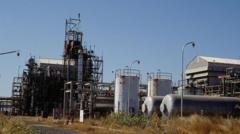Over 337 tonnes of toxic waste have been removed from the Union Carbide plant in Bhopal, India, in compliance with a court order. This significant cleanup comes four decades after a catastrophic gas leak that claimed thousands of lives and has left environmental hazards for years.
Bhopal Toxic Waste Cleared After Four Decades of Inaction

Bhopal Toxic Waste Cleared After Four Decades of Inaction
Authorities successfully remove hazardous material from the infamous Union Carbide plant 40 years after one of history's largest industrial disasters.
In a major development, hundreds of tonnes of toxic waste have been successfully removed from the Union Carbide factory in Bhopal, India, 40 years after one of the most catastrophic industrial disasters in history. The hazardous materials, which included pesticide residue and "forever chemicals," were taken to a specialized incinerator facility 230 kilometers away following a strict four-week deadline imposed by the Madhya Pradesh state High Court in December.
The Bhopal gas tragedy occurred in December 1984, resulting in thousands of deaths due to the exposure to poisonous gas leaked from the factory. The toxic waste, comprising around 337 tonnes of hazardous materials, had been lying dormant in the abandoned facility, contaminating the local groundwater and posing health risks to surrounding communities.
Transportation of the waste was executed under tight security. Special sealed containers were used, and a convoy of vehicles, including police escorts, ambulances, and quick response teams, ensured safe delivery to the disposal site. The removal process began on a Sunday with workers packing the waste into leak-proof bags, which were then loaded onto 12 sealed trucks for transport.
Despite the significance of the cleanup, concerns have been raised by residents and activists about the environmental impact of incineration. They recall incidents in 2015 when a small amount of waste was burned, leading to further contamination of soil and water in the nearby areas. However, Swatantra Kumar Singh, the head of the Bhopal gas tragedy relief department, reassured the public that stringent measures are in place to prevent pollution from emissions or residual ash.
Efforts to dispose of the remnants of the disaster have faced numerous setbacks over the years, primarily due to local opposition and environmental concerns. Past attempts to relocate the waste to various locations, including Gujarat, Hyderabad, and Maharashtra, were abandoned amid protests.
The Bhopal gas tragedy remains one of the largest industrial catastrophes globally, with official reports estimating around 3,500 deaths in the immediate aftermath and over 15,000 fatalities in the ensuing decades. Activists argue that the true death toll is likely even higher, and many survivors continue to grapple with the long-term health consequences of the disaster.
In a landmark case in 2010, an Indian court convicted seven former managers of the plant, issuing minor fines and short prison sentences. Despite these actions, victims and advocates for justice maintain that accountability for this tragedy has yet to be adequately addressed.





















